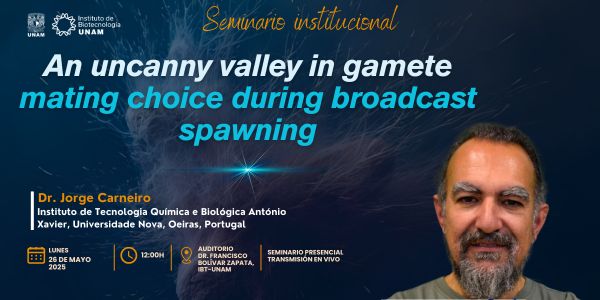
26May - 2025
An uncanny valley in gamete mating choice during broadcast spawning
12:00 PM - 02:00 PM|Dr. Jorge Carneiro| Instituto de Tecnologia Química e Biológica António Xavier, Universidade Nova, Oeiras, Portugal |Invitado por: Dr. Alberto Darszon
Seminario
Most marine invertebrates reproduce via external fertilisation during broadcast spawning events, where males and females of different species simultaneously release sperm and eggs into the water. The burden of heterospecific fertilisation imposes selective pressure for effective gamete mating choice mechanisms. One such mechanism is the directed swimming of spermatozoa toward chemoattractants released by conspecific eggs. Drawing on experimental data and mathematical modelling of sea urchin sperm behaviour, I will argue that their sensorimotor system not only enables chemoattractive responses to conspecific eggs but also mediates aversive relocation when encountering related heterospecific eggs. I will discuss some implications of this “uncanny valley” in gamete recognition for the evolution of chemoattractants and for speciation.
Actualizado 2025-05-21 20:04:27
26-Mayo-2025 al 26-Mayo-2025
12:00 PM
Dr. Jorge Carneiro
12:00 PM
Dr. Jorge Carneiro
An uncanny valley in gamete mating choice during broadcast spawning
Most marine invertebrates reproduce via external fertilisation during broadcast spawning events, where males and females of different species simultaneously release sperm and eggs into the water. The burden of heterospecific fertilisation imposes selective pressure for effective gamete mating choice mechanisms. One such mechanism is the directed swimming of spermatozoa toward chemoattractants released by conspecific eggs. Drawing on experimental data and mathematical modelling of sea urchin sperm behaviour, I will argue that their sensorimotor system not only enables chemoattractive responses to conspecific eggs but also mediates aversive relocation when encountering related heterospecific eggs. I will discuss some implications of this “uncanny valley” in gamete recognition for the evolution of chemoattractants and for speciation.



